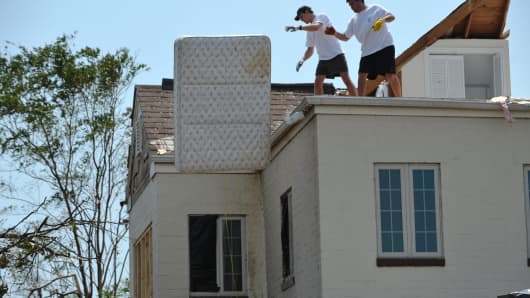When the housing market went bust, house flippers went into hibernation. Now, as the recovery creeps along, bargain-hunters are once again looking for homes to fix up and resell for a quick profit.
Just take a look at the numbers. Home values are on the rise, with a year-over-year price increase of 11.6 percent, according to the National Association of Realtors. Inventory has cratered to levels not seen since 2005.
Irvine, California-based RealtyTrac, an online marketplace for foreclosure properties, says that flipping - defined as buying and selling a property within six months - rose for the second year in a row, up a slight 0.33 percent in 2012 after logging a 12 percent increase in 2011. Those deals were churning out real gross profits, at an average of $37,375 per transaction for all of 2012.
Today's flippers have learned some hard lessons. The housing crash of 2006-2011 wiped out more than $7 trillion in household wealth across the nation, according to data from the Federal Reserve. The fallout left countless speculators holding properties they could no longer move.
This time, homebuyers are being more selective - putting more money down and making calculated bets on smart renovations.
"There are fewer real estate investors now, compared to during the boom. But this time, they have really done their homework," says Andy Heller, author of "Buy Low, Rent Smart, Sell High: Real Estate Investing for the Long Run."
Here are a few tenets to hold close, as you tiptoe back into this dangerous game:
1. Pick your spots
The best places to flip in 2012 included Orlando, Florida; Richmond, Virginia; Tucson, Arizona; and Charlotte, North Carolina, according to RealtyTrac. Flipped homes in Orlando, for instance, were bought for an average of $100,397 and sold for an average of $174,895, for gross profits of almost $75,000.
Jon Maddux, a San Diego-based house flipper and founder of the site AfterForeclosure.com, also found luck in Atlanta, Georgia - far beyond his local region. The one-year average price increase their stands at 13.4 percent, according to the S&P/Case-Shiller Home Price Indices, 2 percent above the national average.
Last year, Maddux, 39, and a business partner bought two single-family homes. The first they bought for $62,900, put in about $28,000 of renovations, and sold for $139,000. The second house they purchased for $79,000, chipped in $25,000 to rehab, and sold for $149,000.
A caveat: Since home prices are not exactly secret information, it means if you find a promising area to invest, other flippers will likely be there, too.
2. Cash is king
During the housing boom, late-night infomercials blared about how anyone could flip a home without putting in a dime of their own.
But this time, banks have tight restrictions, and that means real estate investors coming in with all-cash deals have the upper hand. They can move faster and offer quicker closes than, say, first-time homebuyers who are constantly having to wrangle with their bank
Even better, having cash on hand "can actually generate you some significant discounts on the deal," says Heller.
3. Renovations matter, but stick to a budget
In today's market, you will likely only get a bargain if the house is in truly rough condition. There is no shortage of homes that need upgrades, though. In 2012 there were 1.8 million properties in America with foreclosure filings, according to RealtyTrac, many of them in poor condition.
While every property is different, Maddux suggests spending up to around 25 percent of your expected sale price on necessary upgrades. Exceed that level, and the economics of your flip start to get riskier, with scant room for error if buyers do not show up.
The renovations that offer you the most money back upon resale, according to Remodeling Magazine's 2013 Cost vs. Value Report: Unsexy projects like window replacements, minor kitchen remodels and fixing garage doors.
Heller likes to focus on the basics - doing a fresh paint job, installing gleaming new floors, fixing any problems like leaks - and then providing an additional "improvement allowance," so the new buyer can tailor the home to their personal specifications.
With his latest project in Marietta, Georgia, he bought a single-family home for $205,000. Heller put in $17,000 worth of upgrades, most of it for a paint job and new flooring. He got an offer within a few weeks for $270,000.
4. Be prepared to hold
Back in 2003 the Federal Housing Administration (FHA) instituted anti-flipping regulations, prohibiting insuring a mortgage on a property owned by the seller for less than 90 days.
Those rules have been waived since 2010, in a bid to support the housing market. But a quickly-flipped home requires documentation on renovations, as well as additional appraisals, to justify a much higher resale price if the deal involves an FHA-insured loan. And in practice, many skittish banks still adhere to the 90-day rule, says Maddux. That is why the average flipping time from purchase to resale is just over that level, at 106 days, according to RealtyTrac.
"That seems to be the sweet spot for a profitable deal," says Daren Blomquist, vice president at RealtyTrac. "Back in the housing bubble, many flippers were solely relying on price appreciation, sitting back and selling for big profits within a month or two." Now, real improvements are needed, he says.
Do not expect to flip the property within days and realize lightning-quick profits. You may want to rent it out for a while as the housing market continues to recover, says Heller, in order to cover some costs and eventually secure an even higher resale price.
"In some ways, this is a dream environment," Heller says. "You would be crazy to be on the sidelines."


